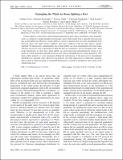Entangling the whole by beam splitting a part
Abstract
A beam splitter is a basic linear optical element appearing in many optics experiments and is frequently used as a continuous-variable entangler transforming a pair of input modes from a separable Gaussian state into an entangled state. However, a beam splitter is a passive operation that can create entanglement from Gaussian states only under certain conditions. One such condition is that the input light is suitably squeezed. We demonstrate, experimentally, that a beam splitter can create entanglement even from modes which do not possess such a squeezing provided that they are correlated to, but not entangled with, a third mode. Specifically, we show that a beam splitter can create three-mode entanglement by acting on two modes of a three-mode fully separable Gaussian state without entangling the two modes themselves. This beam splitter property is a key mechanism behind the performance of the protocol for entanglement distribution by separable states. Moreover, the property also finds application in collaborative quantum dense coding in which decoding of transmitted information is assisted by interference with a mode of the collaborating party.
Citation
Croal , C , Peuntinger , C , Chille , V , Marquardt , C , Leuchs , G , Korolkova , N & Mišta Jr. , L 2015 , ' Entangling the whole by beam splitting a part ' , Physical Review Letters , vol. 115 , no. 19 , 190501 . https://doi.org/10.1103/PhysRevLett.115.190501
Publication
Physical Review Letters
Status
Peer reviewed
ISSN
0031-9007Type
Journal article
Description
L. M. acknowledges support through Project No. P205/12/0694 of GACR. N. K. is grateful for the support provided by the A. von Humboldt Foundation. C. C. and N. K. acknowledge the support from the Scottish Universities Physics Alliance (SUPA) and the Engineering and Physical Sciences Research Council (EPSRC). The project was supported within the framework of the BMBF Grant “QuOReP” and in the framework of the International Max Planck Partnership (IMPP) with Scottish Universities. C. C. and C. P. contributed equally to this work.Collections
Items in the St Andrews Research Repository are protected by copyright, with all rights reserved, unless otherwise indicated.

